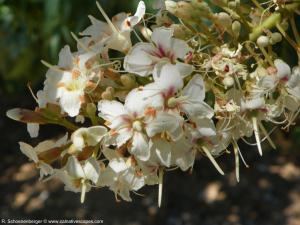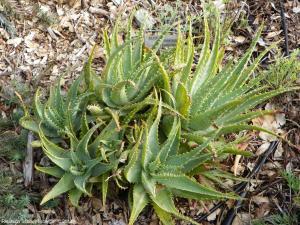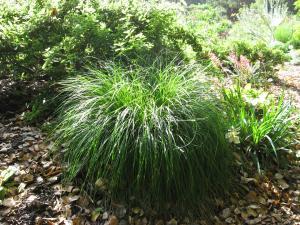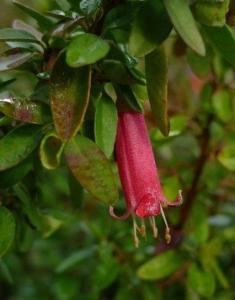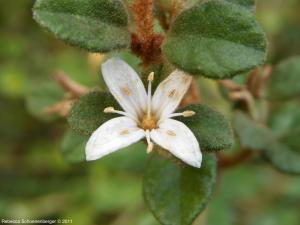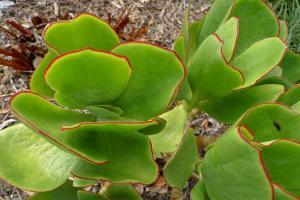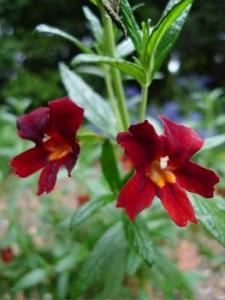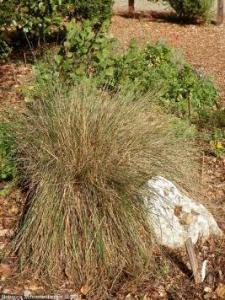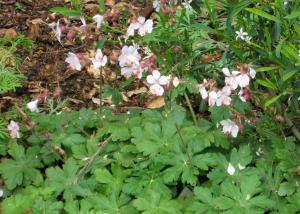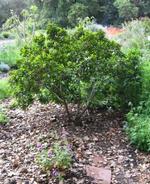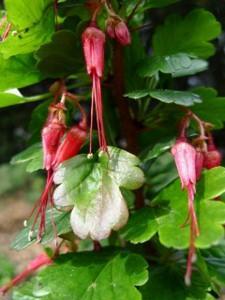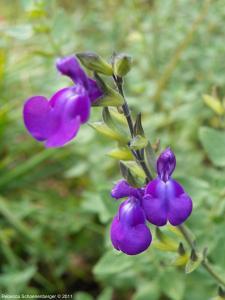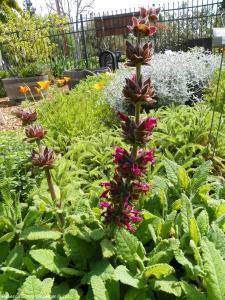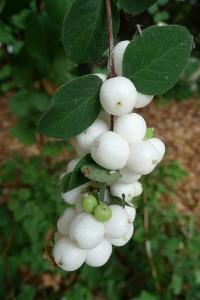Water Wise Plants
Here's a full list of all our water wise plants. You can also view an image gallery, or view the plants by categories.
Aesculus californica
Pronunciation
ES-kew-lus ka-li-FOR-ni-ka
Common Name
California Buckeye
Plant Type
Tree
Mature Size
Can grow 10 - 25 ft. or more, and spread 30 ft. or wider
Water Requirements
Very Low: water deeply several times a summer
Sun/Shade Requirements
Full to half sun, shade
Wildlife
Flower Color
White to pink
Where to See
Maintenance- Design- Planting Tips
The California buckeye is an unusual native because it is summer deciduous. It will naturally drop its leaves with the heat of summer, but with regular watering it may hold leaves longer. Its nectar/pollen is poisonous to European honeybees, but not to native bees. The flower has a candy or perfume-like scent, and blooms in very early spring.
The tree produces a large nut that resembles a buck's eye, thus the name. The nut is poisonous to eat. The nuts easily reseed where they fall, so collect them if new sprouts are not desired. Without summer leaves, the pale bark of the California buckeye offers interest and structure in the garden and is very easy to prune and shape. |
Aloe x spinosissima
Pronunciation
AL-oh spin-oh-Siss-e-ma
Common Name
Spider Aloe
Plant Type
Succulent
Mature Size
2-3 ft. high, 2-4 ft. wide
Water Requirements
Very Low: water deeply several times a summer
Sun/Shade Requirements
Full to half sun, shade
Wildlife
Flower Color
Red-orange
Where to See
Maintenance- Design- Planting Tips
Spider aloe is a slow-growing succulent, making it unlikely to outgrow its space or crowd its neighbors. This low-maintenance plant is an excellent specimen for a small low-water garden.
It’s a striking plant with an interesting form – it almost looks like a piece of modern sculpture. Spider aloe is frost-tender so be sure to protect it on cold winter nights. PADG notes: In the winter, spider aloe is rumored to have red flower spikes that are attractive to hummingbirds. Unfortunately, this cannot be confirmed because the plant has never bloomed in our location. |
Carex divulsa
Pronunciation
KARE-eks dee-VOOL-sah
Common Name
Foothill Sedge
Plant Type
Grass
Mature Size
2 ft. tall and 1 ft. wide
Water Requirements
Very Low: water deeply several times a summer
Sun/Shade Requirements
Full to half sun, shade
Wildlife
Flower Color
No flowers
Where to See
Maintenance- Design- Planting Tips
Foothill sedge makes a lovely informal ground cover in shady areas. With occasional watering, this plant stays green over the entire summer. It will survive full sun but can begin to look ratty in the summer.
This plant was once considered a California native, but that has recently been disproven. The new name is Carex divulsa, but it may still be sold in nurseries as Carex tumulicola. PADG notes: At the end of winter, many people cut this plant back to several inches above the ground, but that has not been necessary at the demonstration garden. Because plants are in the shade, they don’t become tattered. Reseeding has also not been a problem, probably because of extensive bark mulch and drip irrigation in the water wise garden. |
Correa ‘Dusky Bells’
Pronunciation
KOR-ree-uh
Common Name
Australian Fuchsia
Plant Type
Shrub
Mature Size
6 ft. to 8 ft. wide and 2 ft. to 3 ft. tall
Water Requirements
Low: water every three weeks until the root ball is wet
Sun/Shade Requirements
Full to half sun, shade
Wildlife
Flower Color
Reddish pink to red, cream, orange, and greenish yellow
Where to See
Maintenance- Design- Planting Tips
Correa has many attributes that make it ideal for Bay Area gardeners. It thrives in sun, partial sun, or shade; is deer resistant and bird friendly; has pretty, long-lasting flowers that provide winter color; does well with moderate to occasional water; does not get too big; tolerates our alkaline soil; and is evergreen.
Also, the shrub requires no deadheading or pruning, so it is practically maintenance-free. Look for some of the newer cultivars of Correa that have been bred to produce more visible flowers above the foliage. |
Correa alba
Pronunciation
KOR-ree-uh AL-ba
Common Name
Australian Fuchsia, White
Plant Type
Shrub
Mature Size
8 ft. high and wide
Water Requirements
Low: water every three weeks until the root ball is wet
Sun/Shade Requirements
Full to half sun, shade
Wildlife
Flower Color
Where to See
Maintenance- Design- Planting Tips
Correa alba looks very different from the more commonly grown Correa ‘Dusky Bells’. The flowers are more open and less downward facing than other Correas. The foliage is fuzzy on the back side and the stems are bronzy brown. This shrub can grow to 8 feet by 8 feet without regular pruning.
Like Correa ‘Dusky Bells’, Correa alba thrives in sun, partial sun, or shade; is deer resistant and bird friendly; and has long-lasting flowers. The plant does well with moderate to occasional water, tolerates alkaline soil, and is evergreen. The plant is sensitive to overwatering and overfertilizing. PADG notes: Some find Correas to be short-lived but at the Palo Alto Demonstration Garden, this plant is still going strong after several years in the garden. The beds in garden are mulched with wood chips, but not fertilized and watered deeply with drip irrigation once every three weeks. |
Cotyledon orbiculata var. oblonga ‘Macrantha’
Pronunciation
kot-EE-lee-don Or-bee-kul-AY-tuh
Common Name
Pig's Ear
Plant Type
Succulent
Mature Size
3 ft. tall and 2 ft. wide
Water Requirements
Low: water every three weeks until the root ball is wet
Sun/Shade Requirements
Full to half sun, shade
Wildlife
Flower Color
No flowers
Where to See
Maintenance- Design- Planting Tips
Cotyledon orbiculata has large, bright green, red-edged leaves. Many summer-dry plants have small, fine leaves so these brightly colored, fleshy leaves add a much needed punch to the garden. This is especially important during the quiet months in the fall and winter when not much is blooming.
Like many succulents, Cotyledon orbiculata is easily propagated from cuttings and does well in containers. It is cold hardy to 20–25°F. |
Erythranthe guttata
Pronunciation
er-EE-thranthe goo-TA-ta
Common Name
Monkey Flower
Plant Type
Perennial
Mature Size
2 1/2 ft. tall and wide
Water Requirements
Low: water every three weeks until the root ball is wet
Sun/Shade Requirements
Full to half sun, shade
Wildlife
Flower Color
White, cream, yellow, orange, copper, salmon, red, maroon
Where to See
Maintenance- Design- Planting Tips
Mimulus is a cheerful California native that adds bright color to the garden. This shrubby perennial has been hybridized heavily to produce a rainbow of colors. In the wild, different species of Mimulus can be found from southern Oregon to southern California.
Happy in sun or part shade, these plants prefer good drainage. With supplemental water, you can expect some repeat bloom all summer. Mimulus is a favorite in native plant gardens because of its color range. When new foliage appears at its base in late winter, the plant is ready to be pruned back to the new green growth. This hard pruning will rejuvenate the plant. If there is no growth at the base, then gently pinch the tips to encourage new growth. The scientific name of this plant was recently changed from Mimulus guttatus to Erythranthe guttata. PADG notes: Some Master Gardeners have found this plant to be short-lived; other Master Gardeners have Mimulus plants in their personal gardens that are over five years old and doing just fine. These plants are easy to propagate from cuttings and seeds. |
Festuca californica
Pronunciation
fess-TEW-kuh kal-ih-FOR- nih-kuh
Common Name
California Fescue
Plant Type
Grass
Mature Size
2 ft. high and wide, with inflorescence 2 - 3 ft. high
Water Requirements
Very Low: water deeply several times a summer
Sun/Shade Requirements
Full to half sun, shade
Wildlife
Flower Color
Golden
Where to See
Maintenance- Design- Planting Tips
Festuca californica is a commonly planted California native grass. It is larger than many of the Festucas, reaching two feet or more in height and has a softer more arching habit. Unlike many California natives, this plant can take moderate water and will stay green and lush with regular watering. Without regular summer watering, it will go dormant. Festuca californica is tough and resilient. To prevent reseeding, be sure to deadhead in early summer.
|
Geranium x cantabrigiense ‘Biokovo’
Pronunciation
ji-RAY-nee-uhm kan-tuh-brij-ee-EN-see
Common Name
Cranesbill ‘Biokovo’
Plant Type
Groundcover
Mature Size
6 - 8 in. tall and spreading
Water Requirements
Low: water every three weeks until the root ball is wet
Sun/Shade Requirements
Full to half sun, shade
Wildlife
Flower Color
Pale pink
Where to See
Maintenance- Design- Planting Tips
This pretty ground cover is good for dry shady areas. The pale pink flowers have a long season and complement a variety of plants, from roses to California native shrubs to coast live oaks. It's easy to propagate and transplant to new areas. Just cut off a small piece, plant it directly in the soil and keep it wet until the plant roots. Shear in the fall to get fresh growth in the spring.
Be aware that geranium ‘Biokovo’ can become aggressive and spread quickly if planted in soil that is fertilized and watered regularly. |
Rhamnus californica 'Mound San Bruno'
Pronunciation
RAM-nus kal-ih-FOR-nik-uh
Common Name
Coffeeberry 'Mound San Bruno'
Plant Type
Shrub
Mature Size
5 ft. tall and wide
Water Requirements
None: avoid summer water
Sun/Shade Requirements
Full to half sun, shade
Wildlife
Flower Color
Inconsequential pale yellow
Where to See
Maintenance- Design- Planting Tips
Coffeeberry isn't a flashy shrub, but it does add much needed structure to the native plant bed. The berries on the plant are attractive and beneficial for birds and small mammals.
There are many different varieties of coffeeberry. They can be used as an informal hedge or screen or gently pruned to be a bedding or foundation shrub. 'Mound San Bruno' has a compact growing habit that works well in a perennial bed. PADG notes: The California native coffeeberry 'Mound San Bruno' was planted in a native plant bed that receives both sun and shade. The amount of sun the bed gets varies depending on the time of year and time of day. That's a common condition in many gardens and not all shrubs do well in both sun and shade. The coffeeberry was watered once a week to get it started, but now that it is established, it is only watered once or twice over the summer to wash the dust off the leaves. |
Ribes speciosum
Pronunciation
RIE-bees spes-ee-OH-sum
Common Name
Fuchsia Flowering Gooseberry
Plant Type
Shrub
Mature Size
4-8 ft tall x 6-10 ft wide
Water Requirements
Very Low: water deeply several times a summer
Sun/Shade Requirements
Full to half sun, shade
Wildlife
Flower Color
Red
Where to See
Maintenance- Design- Planting Tips
This California native is a large, spiny shrub that can exist with no summer irrigation. Ribes speciosum will go fully dormant during the summer, therefore it is not recommended as a summer focal plant. As soon as the winter rains begin, the plant will unfold glossy green leaves and fuchsia-like red flowers that bloom all winter. The flowers that hang along the undersides of the long arching branches are loved by hummingbirds.
Because of the spiny branches, this shrub should be kept away from walks. It makes a formidable barrier. |
Salvia Hybrid 'Christine Yeo'
Pronunciation
SAL-vee-uh
Common Name
Sage 'Christine Yeo'
Plant Type
Perennial
Mature Size
12-18 in. high and 24 - 36 in. wide
Water Requirements
Low: water every three weeks until the root ball is wet
Sun/Shade Requirements
Full to half sun, shade
Wildlife
Flower Color
Where to See
Maintenance- Design- Planting Tips
Salvias microphyllas is a shrubby perennial that come in a wide variety of colors and will bloom many months with deadheading. It stays a manageable size in the garden and will not overwhelm neighboring plants.
The flower pictured here is Salvia hybrid 'Cristine Yeo'. It is a cross between Salvia microphylla and Salvia chamaedryoides. PADG Notes: Salvia microphyllas prefer full sun, but this plant is doing well with morning sun and afternoon shade in our garden. It seems a little floppy, which might be a shade issue or just its natural form. With a little work, the Salvia microphyllas can be kept in top form in your garden. At PADG, all flowers are sheared off in early summer and again during fall clean up. This keeps the plant more compact and encourages repeat blooming. In the spring, one third of is oldest stems are pruned out to keep the plant from getting woody. A nice bonus for pruning work -- the leaves of these Salvias smell wonderful. |
Salvia spathacea
Pronunciation
SAL-vee-a spa-THAY-see-a
Common Name
Hummingbird Sage
Plant Type
Perennial
Mature Size
1-2 ft high x spreading
Water Requirements
Very Low: water deeply several times a summer
Sun/Shade Requirements
Full to half sun, shade
Wildlife
Flower Color
Red
Where to See
Maintenance- Design- Planting Tips
Salvia spathacea is a California native plant with an unusually (for California natives) lush appearance. The leaves of this plant are large and can grow up to a foot in length.
The plant spreads by underground rhizomes and can eventually cover a large area. Hummingbird sage can make a colorful ground cover in dry, shady conditions. From spring until fall, flowering stems appear above the foliage. The flower clusters are spaced evenly along the stems creating a bold vertical accent. Light pruning after blooming will help keep this plant neat. PADG Notes: In the PADG Water Wise Garden, we found that too much summer sun burned the leaves and made the plant unattractive. Also, our hummingbird sage spread more aggressively than had been anticipated. A few runners were replanted to shadier spots under oak trees and will be monitored carefully. |
Symphoricarpos albus
Pronunciation
sim-for-ih-KAR-pus AL-bus
Common Name
Snowberry
Plant Type
Shrub
Mature Size
3 - 5 ft. tall and wide
Water Requirements
None: avoid summer water
Sun/Shade Requirements
Full to half sun, shade
Wildlife
Flower Color
Where to See
Maintenance- Design- Planting Tips
When fall and winter come, shrubs with berries and fruit add interest to the garden. Snowberry, a California native, has white berries that show up in the fall and last through winter. These berries are attractive to birds too.
One of the best features of snowberry is it does well in dry woodland conditions. It is a rare shrub that will thrive under a thicket of oak trees. Some people find the branching structure of snowberry to be messy. California Native Plants for the Garden recommends occasional coppicing to improve its appearance. Coppicing means to cut back a plant to about one foot from the ground. This usually works best right before a plant puts out new growth in the spring. PADG Notes: Our snowberries grow in a shady area that gets no summer irrigation.
|







